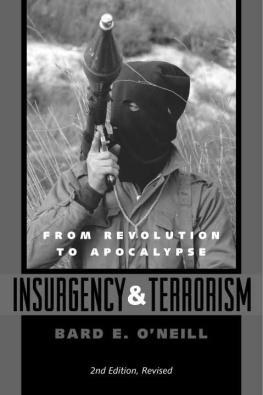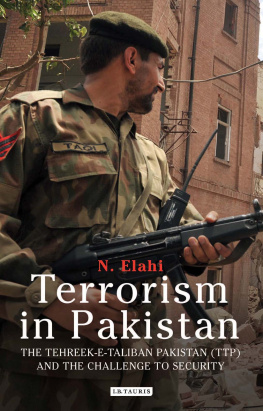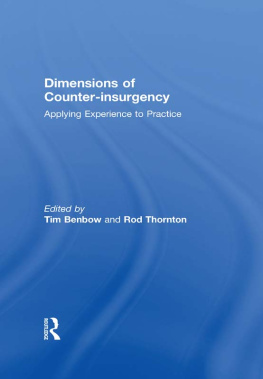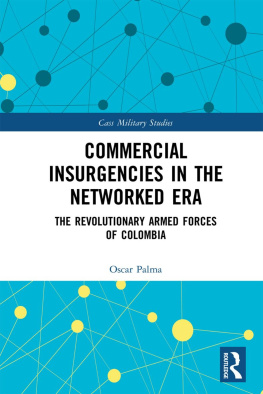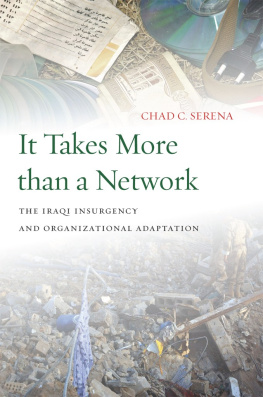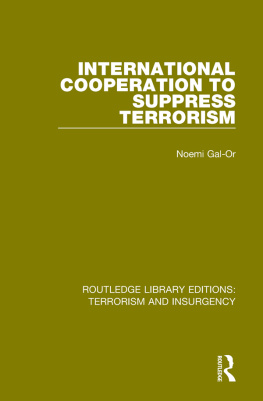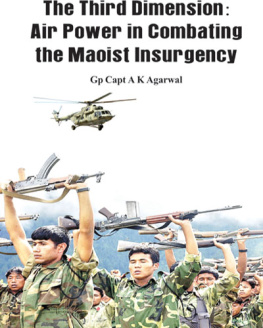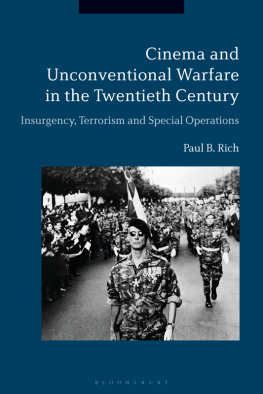
INSURGENCY & TERRORISM
Also by Bard E. O'Neill
The Energy Crisis and U.S. Foreign Policy
Armed Struggle in Palestine
The Deadly Embrace
INSURGENCY &
TERRORISM
FROM REVOLUTION
TO APOCALYPSE
SECOND EDITION
BARD E. O'NEILL





CONTENTS
vii
1 1 15 45 71 93 115 139 155
PREFACE
Forty years ago I developed what became a life-long interest in the subject of insurgency. I was interested in both particular cases and, most especially, how to analyze them. As I pored over the literature, it became evident that there were two kinds of writings on the subject: descriptive and theoretical. Seldom did the two come together, and the theoretical materials often focused on only part of the problem. The more I read, the more I became convinced that there was a need for a comprehensive framework for analysis that integrated and added to the collective understanding and insights about insurgency.
My observations led me to devise a framework for analysis in 1970. Since then, it has appeared in several iterations, each of which has sought to build upon and improve the previous one. After countless case studies-written and oral-and numerous visits to countries facing insurgencies, I decided the time had come to pull together what I had learned and develop a book that would be useful to various individuals and groups interested in the subject, be they participants, observers, scholars, students, or government analysts.
I have kept two subsidiary aims in mind: to keep the book succinct and to avoid being overly theoretical. This is by no means to dismiss the value of more theoretical undertakings, such as Ted Robert Gurr's Why Men Rebel. To the contrary, as the reader will soon discover, I have incorporated a number of ideas from these important works. My purposes, however, are different from theirs. Whereas the theoretical works are intended primarily for academics, I am writing for a more general audience that includes, most importantly, military and civilian members of the national security policy community. Hence, while obviously concerned about explicit and structured analysis, I have tried to tilt away from social science jargon, not because it lacks utility but because it tends to turn off more general readers.
The study of insurgency is fraught with perils because of the zealotry and partisanship that surround the subject. There is no poverty of commentary on issues having to do with supporting or opposing particular insurgencies or broader phenomena such as revolution and counterrevolution. Suffice it to say that I am not interested in taking positions. I am concerned with straightforward, dispassionate analysis of the status of insurgencies that "tells it like it is."
A number of colleagues gave their time to read and critique all or portions of the manuscript. Among those who made constructive suggestions were Dr. William Heaton; Margaret Dean and Ruth Van Heuven, Department of State; Alice Maroni, Congressional Research Service; and Col. Michael Diffley and Col. Terrence "Rock" Salt, U.S. Army. Two friends who were especially important in this undertaking were Dr. Donald J. Alberts and Dr. John Schulz. Dr. Alberts's impressive knowledge of insurgency and his analytical insights were invaluable at many points along the way. Dr. Shultz's painstaking review of the manuscript and numerous editorial suggestions were indispensable.
I would also like to acknowledge Dorle Hellmuth for the terrific job she did finalizing the format of the manuscript. The last steps were accomplished in a smooth and adroit manner thanks to her intelligence, efficiency, and cheerfulness.
I remain indebted to a truly great soldier-scholar, Maj. Gen. Perry M. Smith, USAF Retired, for encouraging and supporting me in the initial undertaking when he was commandant of the National War College.
I would also like to thank the National Defense University Foundation for its continuous and generous support of faculty and student research.
Finally, I would like to express my gratitude to Congressman Ike Skelton for the inspiration and motivation he has provided to the faculty and students of the National War College with his untiring commitment to the qualitative enhancement of professional military education.
Responsibility for this effort is, of course, solely my own. The views expressed herein do not necessarily represent those of either the Department of Defense or the U.S. government.
INSURGENCY IN THE
CONTEMPORARY WORLD
To say that the beginning of the twenty-first century has been tumultuous would be an understatement. If the attacks by Al Qaida and its affiliates and the insurgencies in Iraq and Afghanistan are harbingers of things to come, we are in for continued rough times. This should come as no surprise. In the years prior to September 11, we were faced with an unstable, dangerous, and frequently violent international political environment. In fact, since World War II there was an average of eight wars going on somewhere in the world at any given time. Casualties have been estimated in the unnumbered millions.
The violence is striking in that so much of it occurs in the context of internal wars or insurgencies. Pick up a copy of either the New York Times or the Washington Post on any day, and you are likely to find several articles on insurgencies. These so-called small wars, which can be found on virtually all continents, are often very costly and frequently involve vital or major interests of regional and global powers. The conflicts in Iraq and Afghanistan are striking examples. Because of their continuing and predicted future importance, insurgencies deserve serious and systematic analysis, and in this book, I set forth a way to do precisely that.
Insurgency, of course, is hardly a new phenomenon, as Roman armies could have reported from Gaul, Judea, or elsewhere. Indeed, insurgency has probably been the most prevalent type of armed conflict since the creation of organized political communities. It would be difficult, perhaps impossible, to find many volumes on political history that do not mention rebellions, revolutions, uprisings, and the like.
Our contemporary era is no different; since World War II, terrorism and guerrilla warfare have been predominant types of political violence. Between 1969 and 1985, for instance, the number of major international terrorist incidents alone jumped from just under two hundred to over eight hundred per year, sparking international headlines and leaving people everywhere bewildered, polarized in their opinions, and often afraid. Most of those incidents were the handiwork of insurgent groups seeking to achieve a variety of objectives. Consequently, to understand most terrorism, we must first understand insurgency. We begin the quest for understanding with some preliminary comments on international and domestic factors that have accounted for the prevalence of insurgency since the early 1950s.
Next page
